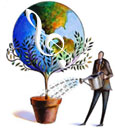

"For over 25 years we have provided legal access to free sheet music without asking anything in return.
If you use and like Free-scores.com, please consider making a donation. Your support will enable us to continue providing free scores to all."
 About free-scores.com / Member testimonies
About free-scores.com / Member testimonies


Central sheet music
3 German Dances, KV 605(6 sheet music)Instrumentation
Winds and String OrchestraGenre
ClassicalTone
F majorArranger
• Editor
Copyright
Public Domain ↗Alternative title
"Schlittenfahrt"Description
Wolfgang Amadeus Mozart (1756 – 1791) was a prolific and influential composer of the Classical period. Despite his short life, his rapid pace of composition resulted in more than 800 works representing virtually every Western classical genre of his time. Many of these compositions are acknowledged as pinnacles of the symphonic, concertante, chamber, operatic, and choral repertoire. Mozart is widely regarded as one of the greatest composers in the history of Western music, with his music admire...
Wolfgang Amadeus Mozart (1756 – 1791) was a prolific
and influential composer of the Classical period.
Despite his short life, his rapid pace of composition
resulted in more than 800 works representing virtually
every Western classical genre of his time. Many of
these compositions are acknowledged as pinnacles of the
symphonic, concertante, chamber, operatic, and choral
repertoire. Mozart is widely regarded as one of the
greatest composers in the history of Western music,
with his music admired for its "melodic beauty, its
formal elegance and its richness of harmony and
texture".
Born in Salzburg, Mozart showed prodigious ability from
his earliest childhood. At age five, he was already
competent on keyboard and violin, had begun to compose,
and performed before European royalty. His father took
him on a grand tour of Europe and then three trips to
Italy. At 17, he was a musician at the Salzburg court
but grew restless and travelled in search of a better
position. Mozart's search for employment led to
positions in Paris, Mannheim, Munich, and again in
Salzburg, during which he wrote his five violin
concertos, Sinfonia Concertante, and Concerto for Flute
and Harp, as well as sacred pieces and masses, the
motet Exsultate Jubilate, and the opera Idomeneo, among
other works.
Most of Mozart's German Dances were written whilst he
held the position of Kammermusicus (Imperial Chamber
Composer) in Vienna. Mozart had been appointed to this
position on 1 December 1787 by Emperor Joseph II. The
position was offered following the death of the former
Kammermusicus, Christoph Willibald Gluck on 15 November
1787. In the position Mozart earned 800 florins a year.
One of the main obligations of his position was to
write music for the court dances and balls that were
held in the Redoutensaal (Public Ballrooms) of the
Imperial Palace in Vienna.
Mozart was an enthusiastic dancer and produced many
dance works, including ten sets of German dances. The
first set was written in February 1787, before Mozart's
appointment to Kammermusicus. The other sets, excluding
K. 611, were written between December 1787 and 1791,
during which Mozart also wrote well known pieces such
as Symphonies 40 and 41, and his opera Così fan tutte.
These were mostly written in sets of six, with one set
of four and one of twelve. Mozart composed this set of
three Teutsche (German Dances) in the early months of
1791. The three dances of K. 605 are usually listed
with the six dances of K. 600 and the four of K. 602 as
Dreizehn deutsche Tänze (Thirteen German Dances). The
pieces first appear on 12 February 1791 on Mozart's
List of all my Works, and are the penultimate set of
German Dances that Mozart composed before his death on
5 December 1791.
Dance 3: "Schlittenfahrt" (The Musical Sleigh Ride) may
have been written independently of the others, as it is
very different in style. Schlittenfahrt means "Sleigh
Ride"; the use of sleigh bells in the piece clearly
emphasises this. Before the sleigh bells enter, there
is a series of repeating phrases that pass between the
trumpets, woodwind and violins. The topography of the
dynamics of the tuned sleigh bells make the piece seem
like a sleigh ride, as the dynamics rise and fall like
a sleigh would over snow. This is followed by a
beautiful but simple posthorn solo that gives a very
peaceful and clear atmosphere to the piece, like a
winter's day. The original repeating phrases then
return, but end with a majestic fanfare from the
trumpets that passes to the other instruments, then
returns to the sleigh bells and posthorn solo again.
The piece ends with a diminuendo of the posthorn
solo.
Source: Wikipedia
(https://en.wikipedia.org/wiki/Three_German_Dances).
Although originally scored for Piccolo, 2 Flutes, 2
Oboes, 2 Bassoons, 2 French Horns, 2 Trumpets, Timpani,
Violins, Cellos & Basses, I created this Arrangement of
"Sleigh Ride" from "3 German Dances" (K.605 No. 3) for
Small Orchestra (Piccolo, Flute, Oboe, English Horn, Bb
Clarinet, French Horn, Bassoon, 2 Violins, Viola, Cello
& Bass).

We value your opinion
Help us improve the new version of Free-Scores.com
How would you rate the new version?
Thank you for your feedback!
Your feedback has been sent to our team.
It will help us improve Free-Scores.com.




